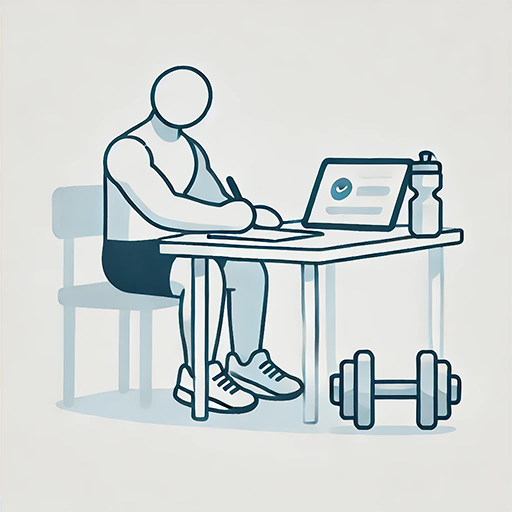How to Build a Time-Efficient Home Workout Routine That Gets Results

Jamal Habib

How to Build a Time-Efficient Home Workout Routine That Gets Results
In today’s fast-paced world, finding time to work out can be a challenge. Whether you’re balancing work, family, or other commitments, heading to the gym isn’t always an option. But that doesn’t mean you can’t build muscle, burn fat, and stay fit from the comfort of your home.
The key? A time-efficient home workout routine that maximizes results in minimal time.
As a NASM Certified Personal Trainer, I specialize in helping clients optimize their workouts—even with limited time and equipment. In this post, I’ll show you how to structure an effective home workout, what exercises to prioritize, and how to get results without spending hours training.
Why Home Workouts Work (If Done Right)
Many people believe home workouts aren’t as effective as gym workouts, but that’s far from the truth. With the right approach, you can achieve incredible results in 20–30 minutes per session.
🏠 Benefits of Home Workouts:
✔️ Saves time – No commuting to the gym
✔️ Cost-effective – No expensive memberships or equipment needed
✔️ Flexible scheduling – Work out on your own time
✔️ Customizable – Adjust workouts based on your goals and fitness level
The trick is to train smarter, not longer, by using compound exercises, progressive overload, and intensity techniques to maximize results.
The key? A time-efficient home workout routine that maximizes results in minimal time.
As a NASM Certified Personal Trainer, I specialize in helping clients optimize their workouts—even with limited time and equipment. In this post, I’ll show you how to structure an effective home workout, prioritize exercises, and get results without spending hours training.
How to Structure a Time-Efficient Home Workout
To get the most bang for your buck, your home workout should focus on:
✅ Full-body or upper/lower body splits
✅ Compound movements (multi-joint exercises)
✅ Minimal rest periods for efficiency
✅ Progressive overload to keep improving
Step 1: Choose the Right Training Format
🔹 Option 1: Circuit Training (Best for Fat Loss & Conditioning)
- Perform 4–6 exercises back-to-back
- Minimal rest between exercises (30–45 seconds)
- Repeat for 3–5 rounds
- 🔥 Example: Squats → Push-ups → Lunges → Rows → Planks
🔹 Option 2: Supersets (Best for Muscle Growth & Strength)
- Pair two exercises targeting different or opposing muscles
- Perform them back-to-back with minimal rest
- 🔥 Example: Squats & Rows | Push-ups & Deadlifts | Core & Glutes
🔹 Option 3: EMOM (Every Minute on the Minute)
- Perform a set amount of reps every minute
- Rest for the remainder of the minute
- 🔥 Example: 10 squats + 10 push-ups every minute for 10 minutes
💡 Pick the format that aligns with your goals and time constraints.
Step 2: Focus on Compound Movements
Compound exercises work multiple muscle groups at once, making them more efficient than isolation exercises.
🔥 Best Bodyweight & Minimal Equipment Exercises:
🏋️ Lower Body:
✅ Squats / Jump Squats
✅ Lunges / Bulgarian Split Squats
✅ Glute Bridges / Step-ups
💪 Upper Body:
✅ Push-ups (Regular, Diamond, Wide)
✅ Dips (Using a chair)
✅ Rows (Using bands or household objects)
🧱 Core & Stability:
✅ Planks (Regular, Side, Shoulder Taps)
✅ Dead Bugs
✅ Bicycle Crunches
🚀 Pro Tip: If you have equipment like resistance bands, dumbbells, or kettlebells, you can add progressive overload by increasing weight, reps, or intensity.
Step 3: Keep Rest Periods Short
To maximize calorie burn and time efficiency, keep rest periods between 15–45 seconds between sets.
💡 Rest Guidelines:
🔹 Fat Loss & Endurance: 15–30 sec rest
🔹 Muscle Growth (Hypertrophy): 30–45 sec rest
🔹 Strength Building: 60 sec rest
⏳ More work in less time = better results.
Step 4: Progressive Overload for Long-Term Results
Even at home, you need progressive overload to keep making gains.
💡 How to Progress Without a Gym:
✔️ Increase reps (e.g., from 10 to 12 reps)
✔️ Add resistance (use dumbbells, bands, weighted backpack)
✔️ Slow down tempo (e.g., lower into a squat for 3 sec)
✔️ Reduce rest time for higher intensity
Example Progression:
🏋️ Week 1: Bodyweight squats (10 reps)
🏋️ Week 2: Add a backpack for extra weight
🏋️ Week 3: Increase to 12 reps per set
🏋️ Week 4: Add jump squats for explosive power
🚀 Small improvements each week lead to big results over time.
Sample 20-Minute Home Workout Routine (Full-Body)
⏳ Format: Circuit Training (3–4 rounds, minimal rest between exercises)
Exercise | Reps/Time |
Jump Squats | 12 reps |
Push-Ups | 12–15 reps |
Bulgarian Split Squats | 10 reps per leg |
Bent-Over Rows (Band or Object) | 12 reps |
Plank (Regular or Shoulder Taps) | 30–45 sec |
Glute Bridges | 12 reps |
🔥 Bonus: If you have extra time, add burpees or mountain climbers at the end for a fat-burning finisher!
How Often Should You Train at Home?
For best results, aim for 3–5 sessions per week, depending on your goals:
✅ Fat Loss & Conditioning: 4–5 days/week
✅ Muscle Growth & Strength: 3–4 days/week
✅ Beginner Routine: 3 days/week
💡 Tip: If you’re short on time, even 10–15 minutes of focused training is better than nothing.
Common Home Workout Mistakes & How to Avoid Them
❌ Skipping Warm-Ups → 🚀 Do dynamic stretches before workouts
❌ Not Pushing Hard Enough → 🚀 Increase intensity with tempo, reps, or resistance
❌ Ignoring Recovery → 🚀 Prioritize mobility & stretching post-workout
❌ Lack of Variety → 🚀 Switch up exercises & formats to stay motivated
Final Thoughts: Train Smart, Get Results
You don’t need hours in the gym to get fit. A well-designed home workout routine can help you burn fat, build muscle, and improve performance—all in 20–30 minutes per session.
🚀 Key Takeaways:
✔️ Prioritize compound movements
✔️ Use efficient training formats (circuits, supersets, EMOM)
✔️ Keep rest periods short for maximum intensity
✔️ Apply progressive overload to keep improving
💪 Ready to take your home training to the next level?
📩 Let’s create a personalized home workout plan tailored to your goals! Contact me today for coaching!
